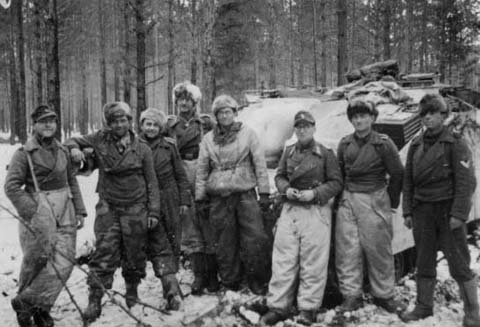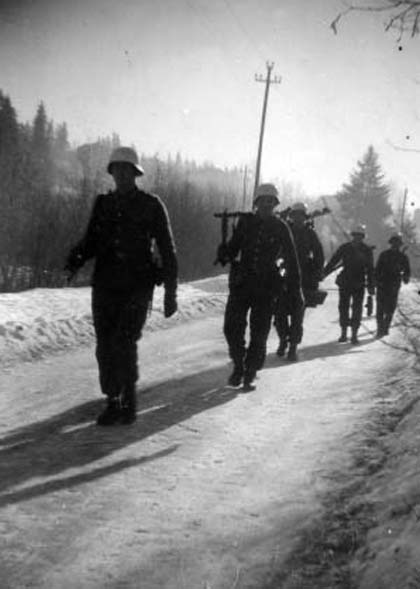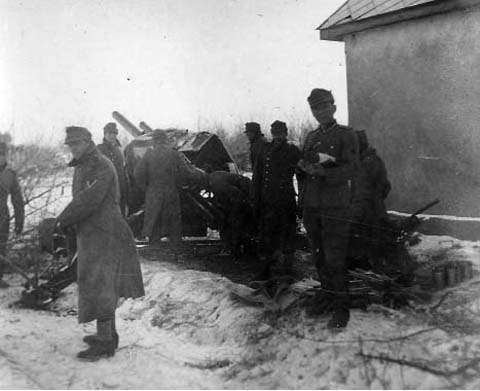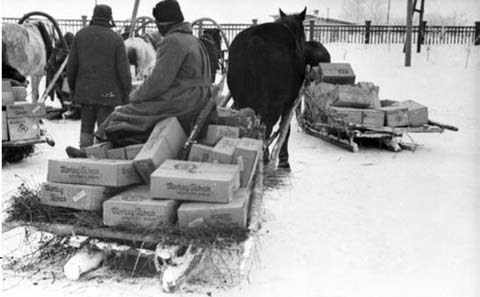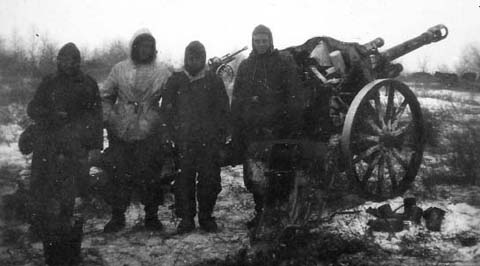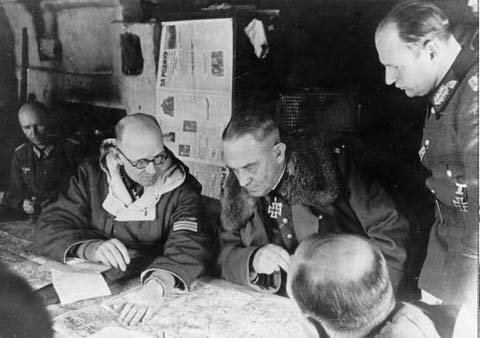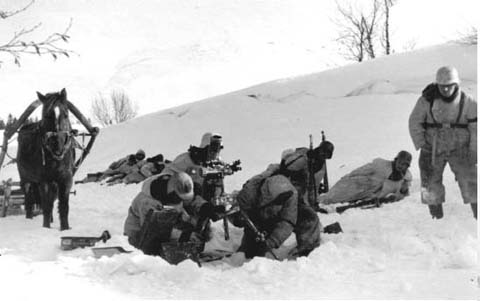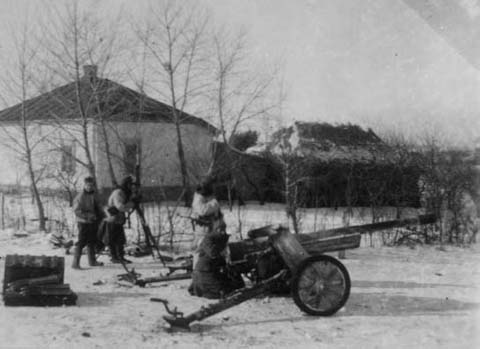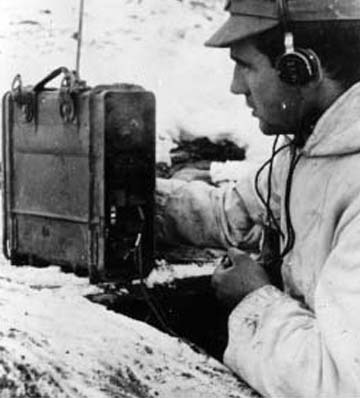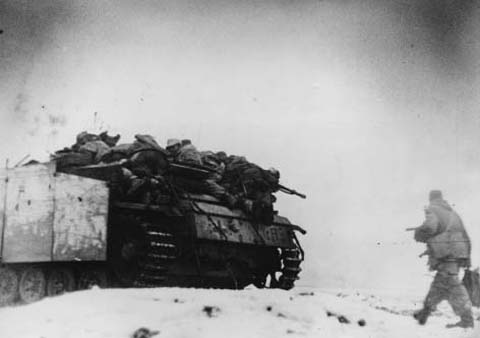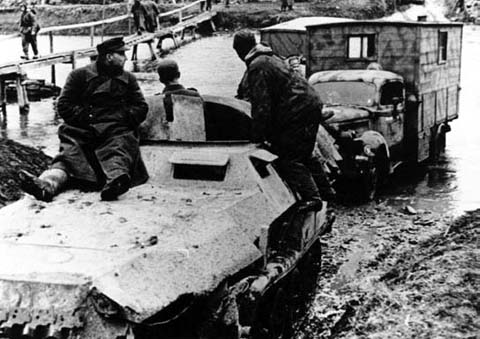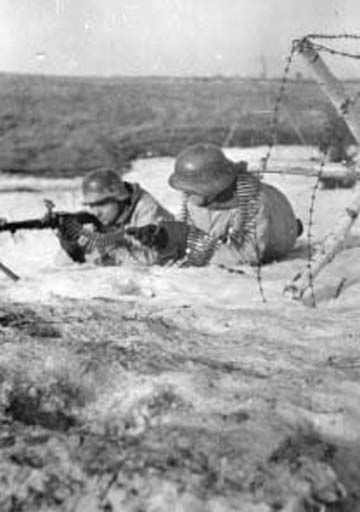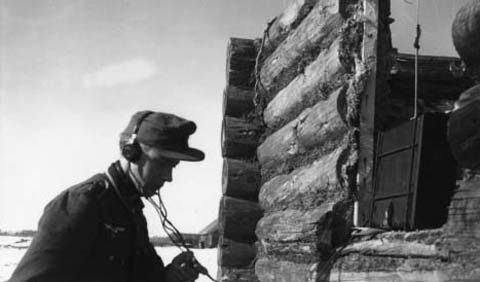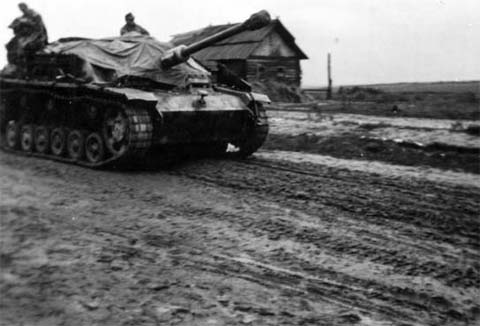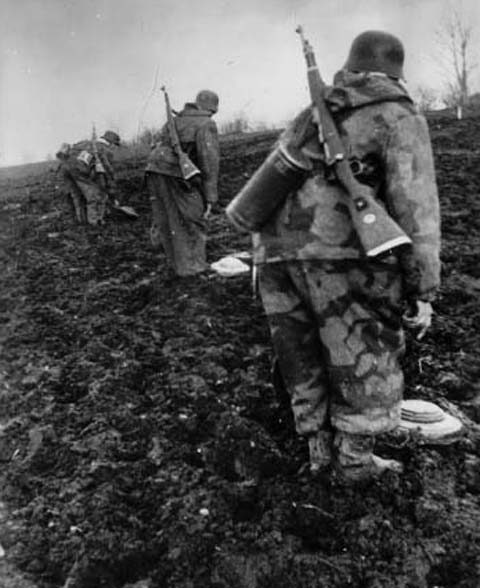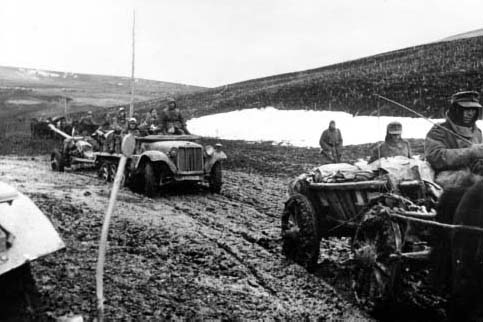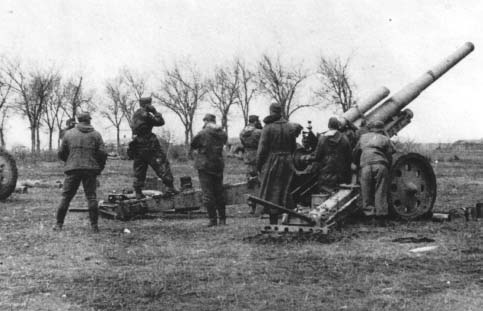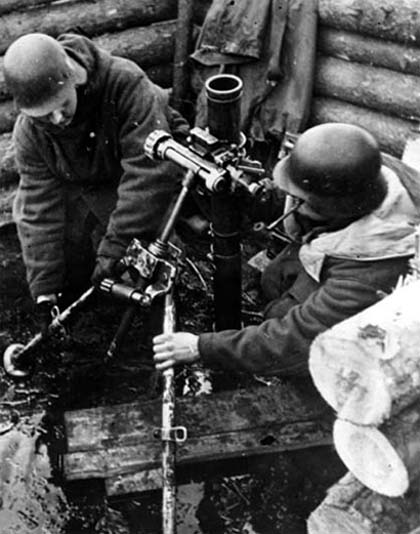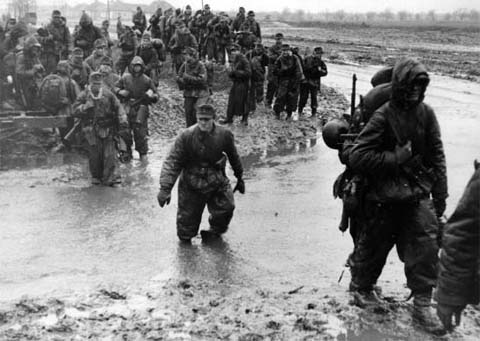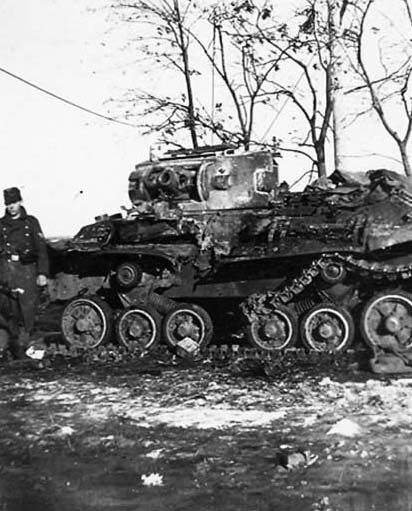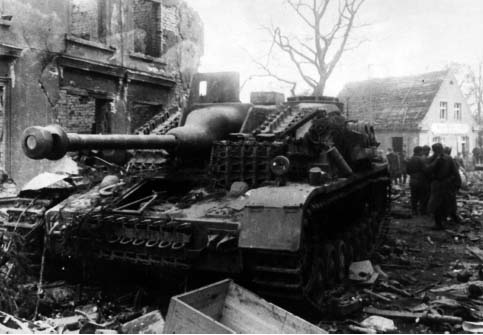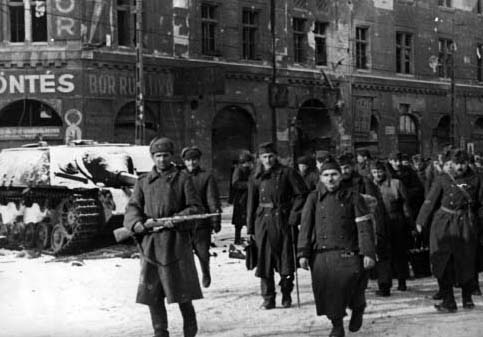Last Battles in the East
The last great offensive that brought the Russians their final victory in the East began during the third week of January 1945. The principal objective was to crush the remaining German forces in Poland, East Prussia and the Baltic states. Along the front an all-out Russian assault had begun in earnest with the sole intention of crushing the remaining understrength German units that had once formed Heeresgruppe Nord. It was these heavy, sustained attacks that eventually restricted the German-held territory in the north-east to a few small pockets of land surrounding four ports: Libau, kurland, Pillau in East Prussia and Danzig at the mouth of the River Vistula.
Here along the Baltic coast the German defenders attempted to stall the massive Russian push with the remaining weapons and men they had at their disposal. Every German soldier defending the area was aware of the consequences of being captured. Not only would the coastal garrisons be cut off and eventually destroyed, but also masses of civilian refugees would be prevented from escaping from those ports by sea. Hitler made it quite clear that all remaining Wehrmacht, Waffen-SS volunteer units, and Luftwaffe personnel were not to evacuate, but to stand and fight and wage an unprecedented battle of attrition. In fact, what Hitler had done by a single sentence was to condemn to death 8,000 officers and more than 181,000 soldiers and Luftwaffe personnel.
In southwest Poland the strategic town of Breslau situated on the River oder had been turned into a fortress and defended by various Volkssturm, Hitlerjugend, Waffen-SS and various formations from the 269.Infantry-Division. During mid-February 1945 the German units put up a staunch defence with every available weapon that they could muster. As the battle ensued, both German soldiers and civilians were cut to pieces by Russian attacks. During these viscous battles, which lasted until May 1945, there were many acts of courageous fighting. Cheering and yelling, old men and boys of the Volkssturm and Hitlerjugend, supported by ad hoc SS units, advanced across open terrain, sacrificing themselves in front of wellpositioned Russian machine gunners and snipers. By the first week of March, Russian infantry had driven back the defenders into the inner city and were pulverising it street by street. Lightly clad SS, Volkssturm and Hitlerjugend were still seen resisting, forced to fight in the sewers beneath the decimated city. When Breslau finally capitulated almost 60,000 Russian soldiers were killed or wounded trying to the capture the town, with some 29,000 German military and civilian casualties.
Elsewhere on the Eastern Front, fighting was merciless, with both sides imposing harsh measures on their men to stand where they were and fight to the death. With every defeat and withdrawal came ever-increasing pressure on the commanders to exert harsher discipline on their weary men. The thought of fighting on German soil for the first time resulted in mixed feelings among the soldiers. Although the defence of the Reich automatically stirred emotional feelings to fight for their land, not all soldiers felt the same way. More and more young conscripts were showing signs that they did not want to die for a lost cause. Conditions on the Eastern Front were miserable not only for the newest recruits, but also for battlehardened soldiers who had survived many months of bitter conflict against the Red Army. The cold harsh weather during February and March prevented the soldiers digging trenches more than a metre down. But the main problems that confronted the German forces during this period were shortages of ammunition, fuel and vehicles. Some vehicles in a division could only be used in an emergency and battery fire was strictly prohibited without permission from the commanding officer. The daily ration on average per division was for two shells per gun.
As the great Red Army drive gathered momentum, more towns and villages fell to the onrushing forces. Suicidal opposition from a few SS and Wehrmacht strong points bypassed in earlier attacks reduced buildings to blasted rubble. Everywhere it seemed the Germans were being constantly forced to retreat. Many isolated units spent hours or even days fighting a bloody defence. Russian soldiers frequently requested them to surrender and assured them that no harm would come to them if they did so. But despite this reassuring tone, most German troops continued to fight to the bitter end. To the German soldier in 1945 they were fighting an enemy that they not only despised, but were also terrified of. Many soldiers, especially those fighting in the ranks of the Waffen-SS decided that would meet their fate out on the battlefield. To them they would rather bleed fighting on the grasslands of Eastern Europe than surrender and be at the mercy of a Russian soldier.
Along the Baltic States the German soldier too was totally aware of the significance if it were lost. They knew that their Führer was determined more than ever to drag out the war and help stave off a Russian drive on Berlin. For this reason he told his battlefront commanders to instil every soldier to fight to the death for every city, town and village. one such city he was fanatical in defending was the ancient Teutonic city of Danzig. Danzig was populated almost exclusively by Germans and before the war had been designated a free city giving Poland access to the Baltic Sea. This had angered Hitler bitterly and churned-up great bitterness and a determination to reclaim the city back. It was on this pretence that Hitler attacked Poland in 1939, and engulfed Europe into a World War. Now five years later he was determined not to let the city fall without a bloody fight.
For some weeks Danzig had been preparing itself for a long-drawn out defence. Fighting to the east of the city in early March 1945 was the 2.Armee. For several days the 2.Armee fought well against the full weight of the Second Belorussian Front. A number of German divisions put up a staunch defence notably from the 4.Panzer-Division. However, fighting was so fierce that the division was savagely mauled and pushed westwards with its remnants doggedly combating from one fixed position to another.
Inside the city Danzig was being defended by a mixture of infantry, Panzertruppen, Volkssturm, and Hitlerjugend. The main armoured force comprised of the 4.Panzer-Division which consisted of Panzer-Regiment 35, Artillerie-Regiment 103, and Panzer Aufklaerungs Abteilung 4, and two regiments of Panzergrenadiere. The first battalion of the Panzer-Regiment 35 was equipped with Panther tanks, while the second battalion was equipped with Pz.kpfw IV’s. The artillery regiment was equipped mainly with Wespe and Hummel self-propelled howitzers, and towed howitzers and guns.
Although the Germans were poorly matched in terms of equipment and supply a number of the troops were hardened veterans that had survived some of the most costly battles in the East. Hurriedly these troops were positioned along the main roads leading into the city. Heavy machine gun platoons dug-in and held each end of the line while the remainder were scattered in various buildings. Armoured vehicles from Panzer-Regiment 35 took-up key positions in order to defend the main thoroughfare leading into the centre of the city, although not one single tank was battle ready. Crude obstacles were also erected, and troops were emplaced in defensive positions armed with a motley assortment of anti-tank and Flak guns, machine guns, Panzerfaust and the deadly Panzerschrek.
When Russian tanks were identified entering the suburbs on 24 March, Wehrmacht, Panzertruppen, Volkssturm, and Hitlerjugend laden with guns and ammunition, suddenly sprang into action. Moving rapidly through the deserted streets Russian tanks pushed forward accompanied by infantry. In an instant the Germans opened-up a crescendo of fire. A number of Soviet tanks burst into flames before they could wrench open a route into the city. However, superior Soviet strength soon began overwhelming the suburbs. For hours it seemed each soldier was engaged in an individual contest of attrition. House to house fighting raged. Infiltrating the buildings Russians fought a series of deadly hand-to-hand battles with Germans using bayonets, knives and grenades. Anti-tank, machine gun and mortar fire were brought to bear on anything that moved. Germans commanders were all too aware of the significant strength of their resilient foe and hoped that they could contain the Red Army for as long as possible. The Russians mercilessly tore through the suburbs of the city and lay to waste every building in its path. A mixture of armoured vehicles mainly from Panzer-Regiment 35, tried to contain parts of the city from becoming overrun. The attack through the city was swift, but from every conceivable point, German troops poured a lethal storm of fire onto the advancing troops.
By 26 March the whole city had been engulfed in a sea of smoke and flame. German troops became more aggressive as the urban battle intensified. Slowly and methodically the Russians began taking one district after another, pushing back the defenders in a storm of fire and heavy infantry assaults. Whole areas were totally obliterated by tanks and artillery. Many Germans that were captured or wounded were executed on the spot and left suspended from the lamp posts as a warning to others. In parts of the city Volkssturm and Hitlerjugend support by a mixture of Wehrmacht and Panzer troops, managed to knock out a number of Russian tanks with Panzerfaust and Panzerschreck. But even these courageous fighters were no match for hardened soldiers that had fought their way bitterly through Russia to the gates of the Reich. German commanders tried their best to instil hope and determination in the poorly armed defenders, but district after district still fell to the Russian advance.
By 29 March those that had not been encircled or annihilated inside the city fled to mouth of the Vistula. Although the following day Danzig fell, resistance was not totally suppressed. A number of defiant groups that had been encircled and refused to capitulate fought on until they were annihilated.
Elsewhere along the Baltic coast and further south on the German central front the situation for the German Army was spiralling out of control, in spite fanatical resistance. German commanders in the field now resigned themselves with the gloomy prospect of not being able of hold back the Red Army for any appreciable length of time, and the news sent shock waves through the German High Command. For them it marked the beginning of the Soviet invasion of the Fatherland. As German forces fought to delay the inevitable capture of East Prussia, the main bulk of the Red Army drive bypassed various pockets of resistance and spilled out into eastern Pomerania and the Prussian province of Pomerania, where it fought a number of hard-pressed battles.
A StuG.III Ausf. G crew pose for the camera inside a snow covered forest. By January 1945 the equipment situation had deteriorated greatly, especially in the armoured units. The condition of German formations was a constant concern for the tacticians. Even in January and February 1945 they still did receive some tanks, artillery and assault guns, but this was in stark contrast to the enormous volume of armaments being produced by the Russians. The Germans were thus faced with a dangerous and worsening prospect of soon being defeated on home soil.
Troops marching along a frozen road. All along the battered and blasted front German troops tried in vain to hold their positions against overwhelming odds. Whilst a number of areas simply cracked under the sheer weight of the Russian onslaught, there were many places where German units continued to demonstrate their ability to defend the most hazardous positions against well-prepared and greatly superior enemy forces.
The crew of a 10.5cm FH 18 rest during a lull in the fighting. The sheer power of this weapon could hurl its destructive charge up to 10,675m (11,675yds) away. By 1943 only a few of these guns remained in active service and were used mainly in Russia until the end of the war.
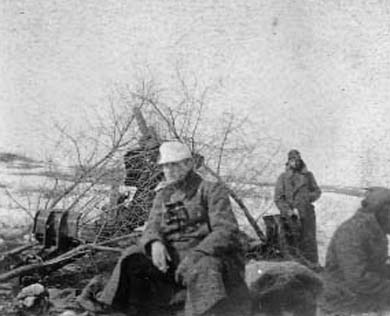
A photograph showing a 10.5cm FH 18 heavy field howitzer being readied for action beside a building. The 10.5cm field howitzer was designed to attack targets deeper into the enemy rear. This included command posts, reserve units, assembly areas, and logistic facilities.
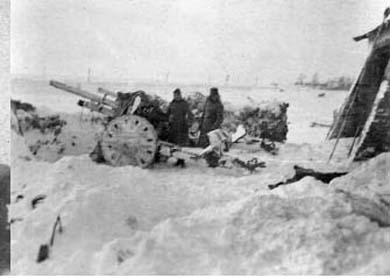
Out in the snow is a 10.5cm howitzer in a field. It was primarily the artillery regiments that were given the task of destroying enemy positions and fortified defences and conducting counter-battery fire prior to an armoured or infantry assault.
Troops of Army Group North with supplies on a sled. The Red Army looked upon their winter offensive as the last great push on the Eastern Front. The principal objective was to crush the remaining German forces in Poland, East Prussia and the Baltic states. Along the Baltic an all-out Russian assault had begun in earnest with the main intention of crushing the remaining understrength German units of the once vaunted Army Group North.
An infantry gun crew belonging to a battery of 10.5cm FH 18/40 pose for the camera. Throughout the war the 10.5cm gun provided both the Wehrmacht and Waffen-SS with a versatile, relatively mobile, base of fire.
A well concealed PaK gun in the snow. A typical strongpoint deployed along the German front comprised mainly of MG34 and MG42 machine guns, an anti-tank rifle company or battalion, a sapper platoon that was equipped with a host of various explosives, infantry guns, anti-tank artillery company which had a number of anti-tank guns, and occasionally a self-propelled gun.

Wehrmacht officers converse during operations to defend the Homeland. Whilst it appeared that the Germans were prepared for a Soviet attack, much of the equipment employed along the defensive belts was too thinly spread. Commanders were also unable to predict exactly where the strategic focal point of the Soviet attack would take place. To make matters worse when the Russians begun heavily bombing German positions all along the German frontier, this also severely weakened the strongest defensive lines.
SS troops at a field kitchen probably during operations in the Baltic region in January or February 1945. German commanders in the field now resigned themselves to the gloomy prospect of losing much of their defensive positions in the east. For them it marked the beginning of the Soviet invasion of the Fatherland. As German forces fought to delay the inevitable capture of East Prussia, and Poland, the main bulk of the Red Army drive bypassed various pockets of resistance and spilled out into eastern Pomerania, where it fought a number of hard-pressed battles.
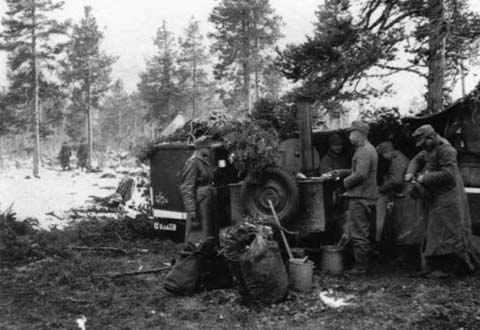
A mortar crew engage an enemy target during a defensive action. Despite the best efforts of the German Army to bolster its dwindling ranks on the Eastern Front during the last months of the war, nothing could mask the fact that they were dwarfed by the superiority of the Red Army. It was estimated that the Russians had some six million men along a front, which stretched from the Adriatic to the Baltic.
A familiar sign in the east during the early winter of 1945. Here a column of Wehrmacht troops trudge westward along a frozen muddy road. Even by 1945 horse drawn power was still the most used form of transportation in the German Army.
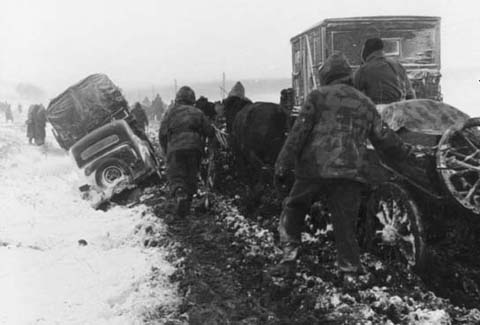
A 5cm PaK 38 gun positioned on the edge of a village somewhere along the border of Poland with the Reich. Although the Germans were poorly matched in terms of equipment and supply a number of the troops were hardened veterans that had survived some of the most costly battles in the East. Hurriedly these troops were positioned along the main roads leading into Germany. Heavy machine gun platoons dug-in and held each end of the line while the remainder were scattered inside various villages and towns. Armoured vehicles, PaK and FlaK units took up key positions in order to defend the main roads.
A German soldier probably in a forward observation post communicating by radio. This solider wears the reversible winter uniform, which was supplied to front lines troops. The uniform was not only very warm but provided the wearer with greater freedom of movement, especially with personal equipment. This uniform not only helped combat the severity of the cold, but helped prevent overheating during physical exertion.
In a dugout in the snow and a Wehrmacht mortar crew can be seen preparing their 12cm Granatwerfer 42 sGW 42 mortar. This deadly weapon, developed in direct response to encounters with the heavy Russian mortar of the same caliber; the Germans designed a virtual copy of the Red Army weapon.
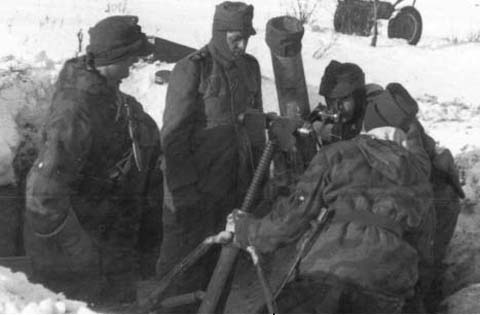
Panzergrenadiers have evidently hitched a lift on board a whitewashed StuG.III Ausf.G during winter operations. Although the StuG had proven excellent against light and medium Soviet tanks at long to medium range, they were vulnerable to attacks from Soviet slit trenches, once they were separated from the heavy machine gun protection of the lighter tanks, vehicles and infantry. As a consequence losses were very high.
A battery of StuG.III Ausf.G out on the battlefield during defensive operations in the East. During the last two years of the war the assault guns had been slowly absorbed into the Panzer units, Panzer and Panzer grenadier divisions of the Wehrmacht and Waffen-SS.
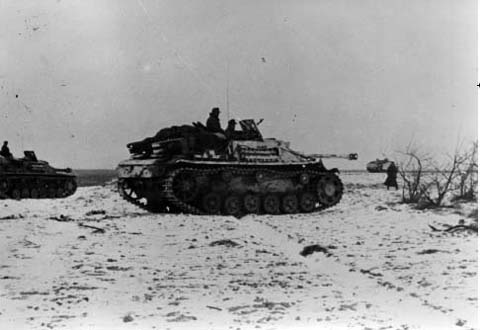
A group of Wehrmacht troops pose for the camera standing in front a white washed transport vehicle.
In spite the dire situation on the front lines troops still sometimes had time to sing and bond with their comrades as this photograph clearly illustrates. Throughout February and March 1945 the Germans continued to fight a frenzied battle of attrition. In many areas where troops fought a determined defence many were encircled and annihilated.

An Sd.Kfz.251 halftrack tows a lorry through a stream during its unit’s withdrawal from Poland across into the Homeland. Whilst many units withdrew under the relentless weight of the Red Army there were many isolated units that spent hours or even days fighting a bloody defence. Russian soldiers frequently requested them to surrender and assured them that no harm would come to them if they did so. But despite this reassuring tone, most German troops continued to fight to the end.
An Sd.Kfz.251 withdraws through Poland as German positions get increasingly pounded by aerial attack. Red Army commanders were well aware of the difficult task of breaking through many of the strong German defensive positions and planned to heavily rely on systematic aerial and ground bombardment. Over the next few weeks hundreds of artillery pieces were drawn-up and positioned by the Russians. In some areas there were some 250 guns per square mile.

Panzergrenadiers move across snowy terrain with a Marder Ausf. M tank destroyer following behind.. Many of the troops were already fatigued, low on ammunition and equipment and would soon be unable to defend the frontier of Poland with the Reich. Among the defenders scattered in various defensive positions, towns and villages were thousands of Volkssturm and Hitlerjugend conscripts and various other local militia and volunteers. These undertrained recruits were hastily brought in to bolster the already depleted Wehrmacht and Waffen-SS forces.
An MG34 light machine gun operator positioned in a field lying next to his feeder. Although the MG34 had by this stage of the war been augmented by the faster-firing MG42, it was still considered a very effective weapon and was used extensively in Russia until the end of the war.
A 7.5m PaK 40 crew during a lull in the defensive fighting. Along the German front lines was a mixture of troops, mortar, tanks, PaK and FlaK guns. Behind these defensive positions at varying depths were anti-tank defences, including mortars, Panzerschreck, Panzerfaust, 7.5cm and 8.8cm PaK guns, ready to counter any enemy armoured vehicle that managed to break through. However, whilst it appeared that the Germans were prepared for a Soviet attack, much of the equipment employed along the defensive belts was too thinly spread. Commanders too were unable to predict exactly where the strategic focal point of the Soviet attack would take place. To make matters worse when the Russians begun heavily bombing German positions all along the frontier, this also severely weakened the strongest defensive lines.
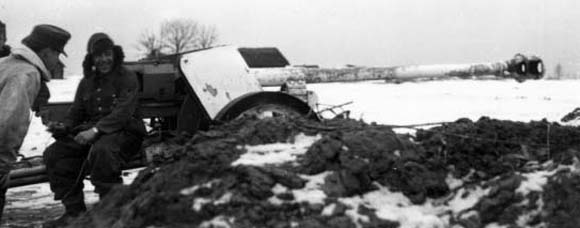
One of the most important forms of defensive action in any battle was communication from the front lines to the command post. Here in this photograph a radioman can be seen with his radio set communicating to one of the many field posts scattered in the rear.
A photograph of an 8.8cm FlaK gun in the snow during a defensive action in Poland in January or February 1945. In some sectors of the front, some units barely had enough Panzers to oppose the Russian armour and called upon FlaK battalions to halt the Red Army’s attacks.
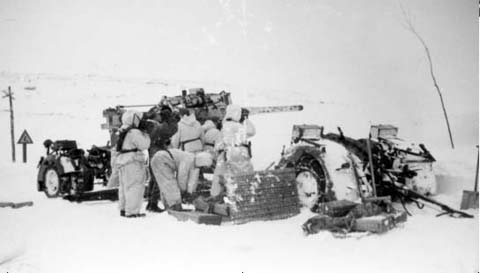
Foreign conscripts in a typical defensive position along the front. Undoubtedly the German soldier was stalling for time, trying their utmost to slow down the Russian drive westwards towards Berlin. Yet there seemed nothing available to him to hold-back the Soviet might, except iron will and fortitude. With determination and fanatical resistance both the German army and their foreign counterparts remained formidable opponents, fighting for every bridge, castle, town and village against the onrushing Red Army. But to the German soldier the defence of the Reich was no normal retreat. They knew very well that the Russians were determined to exact vengeance. As its army steamrolled through into Europe it left a wake of devastation.
A StuG.III Ausf.G advances along a muddy road. From 1943 until the end of the war the assault guns were slowly absorbed into the Panzer units, Panzer, and Panzergrenadier divisions of the Wehrmachtand Waffen-SS. Generally, despite the lack of fuel the StuG.III did remarkably well and fought with distinction, even in defensive actions again enemy armour.
Heavily equipped Panzergrenadiers in undergrowth during defensives actions in March 1945. They are wearing the splinter reversible padded winter jacket and trousers. This splinter pattern camouflage was printed in two shades, light and dark, with each side being made from separate pieces of the two types of camouflage cloth.

Sappers laying Teller mines during a defensive action in March 1945. Although the Germans were poorly matched in terms of equipment and supply a number of the troops were hardened veterans that had survived some of the most costly battles in the East. Hurriedly these troops were positioned along the main roads and other important areas of the front where it was thought that the Red Army would break through. Crude obstacles were then erected, and troops were emplaced in defensive positions armed with a motley assortment of anti-tank and FlaK guns, machine guns, Panzerfaust, Panzerschrek, and where possible mines fields were laid at intervals.
Operations in the Baltic and a column of vehicles including draught animals can be seen towing what remaining supplies there were at their disposal. These forces comprised of what was left of Army Group North. By the end of March the situation for Army Group North, now renamed Army of East Prussia, deteriorated further. Its forces were now hemmed in around the Bay of Danzig from Samland and Königsberg to the mouth of the Vistula. The remnants of two corps were given the task of holding positions north of Gotenhafen on the Hel Peninsula. Hitler demanded that it be held at all costs. He instructed all forces in of Army of East Prussia and Army Kurland, to stay in the front, and then held in order to draw the maximum enemy forces against itself and hopefully away from the main Soviet drive on Berlin.
A 15cm gun crew in a defensive action during the last weeks of the Battle of the Baltic States. During this period as German forces tried to maintain its unstable position in the north the Red Army pulled together its forces into three powerful fronts with the main thrust being directed against Berlin. In the north the 2.Belorussian Front was to cross the Oder north of Schwedt and strike toward Neustrelitz. Its thrust was intended to drive out the defending 3rd Panzer back against the coast and cover the advance toward Berlin on the north. German forces, however, were determined to try and hold their positions for as long as possible and prevent the Russians from taking possession of German territory. But in spite dogged resistance in many places the Germans no longer had the man power, war plant or transportation to defend their positions effectively.
An Sd.Kfz.251 halftrack tows a Horch Cross Country vehicle and a Type 82 Volkswagen Kübelwagen across muddy terrain during its unit’s withdrawal somewhere in the Baltic area earlier in the war. With the capture of Danzig, Zoppot, and Gotenhafen, Hitler reluctantly conceded that the situation along the Baltic was so perilous that an invasion of the Reich would be imminent. Further along the coast other ports were heavily fortified in order to re-supply troops and contain the Red Armies remorseless drive.
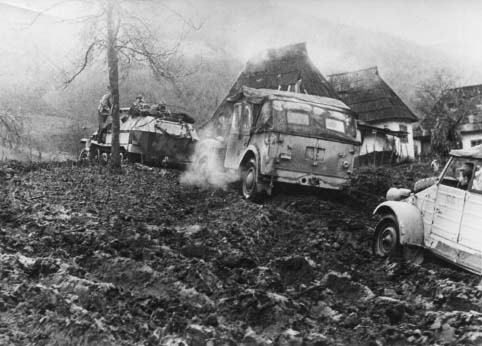
Inside a typical dug-out on the Eastern Front. A mortar crew prepares their weapon for action. They are all wearing the reversible gray/white two-piece winter grey-side out. They blend particularly well into their surroundings.
Troops withdraw across the Vistula River during a furious withdrawal from the might of the advancing Red Army. At the end of March the military situation for the Germans in Poland had deteriorated so badly, in spite of fanatical resistance, that even Hitler himself began reluctantly allowing his forces to withdraw across the Polish frontier into the Reich where he believed they would have a better chance of defence.
A German soldier proudly stands beside a destroyed British or Canadian-built 2 pounder-armed Valentine tank. The German soldier was determined at all costs to knock out as many Red Army tanks as possible, but the constant onslaught of the massive tank armadas meant that in spite of heavy Russian losses there were always more to replace those already knocked out.
During the defence of the Reich and every weapon in the remaining German arsenal was used for its disposal. Here in this photograph among the wreckage of an urbanized battle stands a knocked out StuG.IV. Russian troops can be seen in the background.
What appear to be Hungarian POWs being led away into captivity during the loss of Hungary. The column of POWs passes a knocked out Jagdpanzer IV. The Jagdpanzer was an effective tank destroyer, but by the time it left the factory its unique defensive attributes mattered little anymore.
